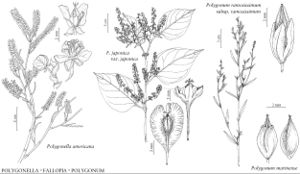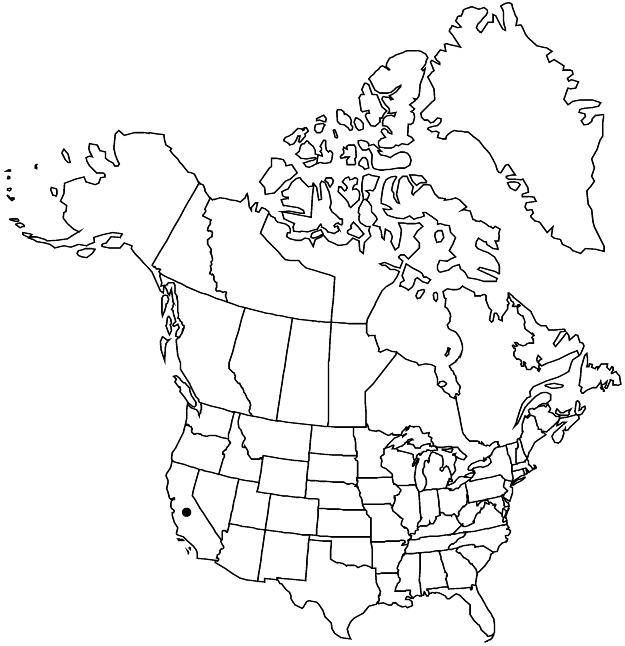Difference between revisions of "Polygonum marinense"
Madroño 18: 87. 1965.
FNA>Volume Importer |
FNA>Volume Importer |
||
| Line 25: | Line 25: | ||
|distribution=Calif. | |distribution=Calif. | ||
|discussion=<p>Of conservation concern.</p><!-- | |discussion=<p>Of conservation concern.</p><!-- | ||
| − | --><p>The origin and taxonomic affinities of Polygonum marinense are uncertain. T. R. Mertens and P. H. Raven (1965) suggested a relationship with P. oxyspermum C. A. Meyer & Bunge or the Mediterranean P. robertii Loiseleur-Deslongchamps. Polygonum marinense may be confused with P. ramosissimum. It can be distinguished by its subsucculent texture, funnelform ocreae, leaves rounded at the apices, and semi-open flowers. Marin knotweed is known from fewer than 15 locations in Marin, Napa, Solano, and Sonoma counties; it is threatened by coastal development.</p> | + | --><p>The origin and taxonomic affinities of <i>Polygonum marinense</i> are uncertain. T. R. Mertens and P. H. Raven (1965) suggested a relationship with <i>P. oxyspermum</i> C. A. Meyer & Bunge or the Mediterranean P. robertii Loiseleur-Deslongchamps. <i>Polygonum marinense</i> may be confused with <i>P. ramosissimum</i>. It can be distinguished by its subsucculent texture, funnelform ocreae, leaves rounded at the apices, and semi-open flowers. Marin knotweed is known from fewer than 15 locations in Marin, Napa, Solano, and Sonoma counties; it is threatened by coastal development.</p> |
|tables= | |tables= | ||
|references= | |references= | ||
| Line 49: | Line 49: | ||
|publication year=1965 | |publication year=1965 | ||
|special status= | |special status= | ||
| − | |source xml=https://jpend@bitbucket.org/aafc-mbb/fna-data-curation.git/src/ | + | |source xml=https://jpend@bitbucket.org/aafc-mbb/fna-data-curation.git/src/8f726806613d60c220dc4493de13607dd3150896/coarse_grained_fna_xml/V5/V5_1125.xml |
|subfamily=Polygonaceae subfam. Polygonoideae | |subfamily=Polygonaceae subfam. Polygonoideae | ||
|genus=Polygonum | |genus=Polygonum | ||
Revision as of 18:36, 18 September 2019
Plants often reddish tinged, heterophyllous, subsucculent. Stems prostrate to ascending, branching from base, not wiry, 15–40 cm. Leaves: ocrea 4–6 mm, proximal part funnelform, distal part silvery hyaline, soon disintegrating, leaving almost no fibrous remains; petiole 2–5 mm; blade often reddish tinged, elliptic to obovate or oblanceolate; 20–35 × 9–16 mm, margins flat, apex rounded; stem leaves (1.3–)2–2.6(–3.5) times as long as branch leaves; distal leaves overtopping flowers in distal part of inflorescence. Inflorescences axillary; cymes in most leaf axils, 1–4-flowered. Pedicels mostly exserted from ocreae, 2–4 mm. Flowers semi-open; perianth 3–3.5(–4) mm; tube 18–25% of perianth length; tepals overlapping, green, margins white or pink, petaloid, not keeled, broadly rounded, cucullate; midveins unbranched; stamens 8. Achenes exserted from perianth, brown, ovate, 3-gonous, 2.8–3.4(–4) mm, faces subequal or evidently unequal, apex not beaked, edges straight, shiny, minutely roughened; late-season achenes uncommon, 4.5–5 mm. 2n = 60.
Phenology: Flowering Apr–Oct.
Habitat: Coastal salt and brackish marshes, swamps
Elevation: 0-10 m
Discussion
Of conservation concern.
The origin and taxonomic affinities of Polygonum marinense are uncertain. T. R. Mertens and P. H. Raven (1965) suggested a relationship with P. oxyspermum C. A. Meyer & Bunge or the Mediterranean P. robertii Loiseleur-Deslongchamps. Polygonum marinense may be confused with P. ramosissimum. It can be distinguished by its subsucculent texture, funnelform ocreae, leaves rounded at the apices, and semi-open flowers. Marin knotweed is known from fewer than 15 locations in Marin, Napa, Solano, and Sonoma counties; it is threatened by coastal development.
Selected References
None.

